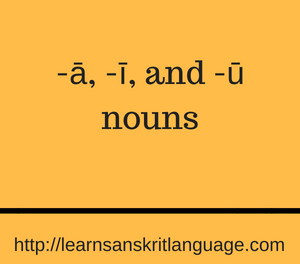These nouns that end in -i and -u Nouns are present in all three genders. There is only one exception as far as the way in which they make endings is concerned.
Now we shall look at how i and u make endings in various genders. However, first we shall look at how these two affect the endings in masculine gender through the table given below.the example we shall take is of the word “Agni” and we look at the endings with –i.
| अग्नि | Singular | Dual | Plural |
|---|---|---|---|
| Case 1 (subject) | अग्निः agniḥ | अग्नी agnī | अग्नयः agnayaḥ |
| Case 2 (object) | अग्निम् agnim | अग्नी agnī | अग्नीन् agnīn |
| Case 3 ("with") | अग्निना agninā | अग्निभ्याम् agnibhyām | अग्निभिः agnibhiḥ |
| Case 4 ("for") | अग्नये agnaye | अग्निभ्याम् agnibhyām | अग्निभ्यः agnibhyaḥ |
| Case 5 ("from") | अग्नेः agneḥ | अग्निभ्याम् agnibhyām | अग्निभयः agnibhyaḥ |
| Case 6 ("of") | अग्नेः agneḥ | अग्न्योः agnyoḥ | अग्नीनाम् agnīnām |
| Case 7 ("in") | अग्नौ agnau | अग्न्योः agnyoḥ | अग्निषु agniṣu |
| Case 8 (address) | अग्ने agne | अग्नी agnī | अग्नयः agnayaḥ |
Now we shall look at the u endings in masculine gender.
| गुरु | Singular | Dual | Plural |
|---|---|---|---|
| Case 1 (Subject) | गुरुः guruḥ | गुरू gurū | गुरवः guravaḥ |
| Case 2 (object) | गुरुम् gurum | गुरू gurū | गुरून् gurūn |
| Case 3 ("with") | गुरुणा guruṇā | गुरुभ्याम् gurubhyām | गुरुभिः gurubhiḥ |
| Case 4 ("for") | गुरवे gurave | गुरुभ्याम् gurubhyām | गुरुभ्यः gurubhyaḥ |
| Case 5 ("from") | गुरोः guroḥ | गुरुभ्याम् gurubhyām | गुरुभ्यः gurubhyaḥ |
| Case 6 ("of") | गुरोः guroḥ | गुर्वोः gurvoḥ | गुरूणाम् gurūṇām |
| Case 7 ("in") | गुरौ gurau | गुर्वोः gurvoḥ | गुरुषु guruṣu |
| Case 8 (address) | गुरौ gurau | गुरू gurū | गुरवः guravaḥ |
As for the feminine gender, the endings are the same as in masculine nouns, however the changes take place in the singular form, look at the table given below to understand this further.the word we shall be taking is “Kirti.”
| गुरु | Singular |
|---|---|
| Case 3 ("with") | कीर्त्या kīrtyā |
| Case 4 ("for") | कीर्तये , कीर्त्यै kīrtaye , kīrtyai |
| Case 5 ("from") | कीर्तेः , कीर्त्याः kīrteḥ , kīrtyāḥ |
| Case 6 ("of") | कीर्तेः , कीर्त्याः kīrteḥ , kīrtyāḥ |
| Case 7 ("in") | कीर्तौ , कीर्त्याम् kīrtau , kīrtyām |
Now let us look at u nouns in singular feminine.
| गुरु | Singular |
|---|---|
| Case 3 ("with") | मृद्वा mṛdvā |
| Case 4 ("for") | मृदवे , मृद्वै mṛdave , mṛdvai |
| Case 5 ("from") | मृदोः , मृद्वाः mṛdoḥ , mṛdvāḥ |
| Case 6 ("of") | मृदोः , मृद्वाः mṛdoḥ , mṛdvāḥ |
| Case 7 ("in") | मृदौ , मृद्वाम् mṛdau , mṛdvām |
Now let us look at how the nueter gender is affected by the I and u endings. The nueter nouns make the use of regular consonant endings, in case of –i singular, in is used, a similar thing can be said about –u. Look at the table given below to understand this further. The example we shall take is of “shuchi”.
| शुचि | Singular | Dual | Plural |
|---|---|---|---|
| Case 1 (Subject) | शुचि śuci | शुचिनी śucinī | शुचीति śucīni |
| Case 2 (object) | शुचि śuci | शुचिनी śucinī | शुचीति śucīni |
| Case 3 ("with") | शुचिना śucinā | शुचिभ्याम् śucibhyām | शुचिभिः śucibhiḥ |
| Case 4 ("for") | शुचिने śucine | शुचिभ्याम् śucibhyām | शुचिभ्यः śucibhyaḥ |
| Case 5 ("from") | शु्चिनः śucinaḥ | शुचिभ्याम् śucibhyām | शुचिभयः śucibhyaḥ |
| Case 6 ("of") | शुचिनः śucinaḥ | शुच्योः śucyoḥ | शुचीनाम् śucīnām |
| Case 7 ("in") | शुचिनि śucini | शुच्योः śucyoḥ | शुचिषु śuciṣu |
| Case 8 (address) | शुचि śuci | शुचिनी śucinī | शुचीति śucīni |
| मृदु | Singular | Dual | Plural |
|---|---|---|---|
| Case 1 (Subject) | मृदु mṛdu | मृदुनी mṛdunī | मृदूनि mṛdūni |
| Case 2 (object) | मृदु mṛdu | मृदुनी mṛdunī | मृदूनि mṛdūni |
| Case 3 ("with") | मृदुना mṛdunā | मृदुभ्याम् mṛdubhyām | मृदुभिः mṛdubhiḥ |
| Case 4 ("for") | मृदुने mṛdune | मृदुभ्याम् mṛdubhyām | मृदुभ्यः mṛdubhyaḥ |
| Case 5 ("from") | मृदुनः mṛdunaḥ | मृदुभ्याम् mṛdubhyām | मृदुभ्यः mṛdubhyaḥ |
| Case 6 ("of") | मृदुनः mṛdunaḥ | मृद्वोः mṛdvoḥ | मृदूनाम् mṛdūnām |
| Case 7 ("in") | मृदुनि mṛduni | मृद्वोः mṛdvoḥ | मृदुषु mṛduṣu |
| Case 8 (address) | मृदु mṛdu | मृदुनी mṛdunī | मृदूनि mṛdūni |



